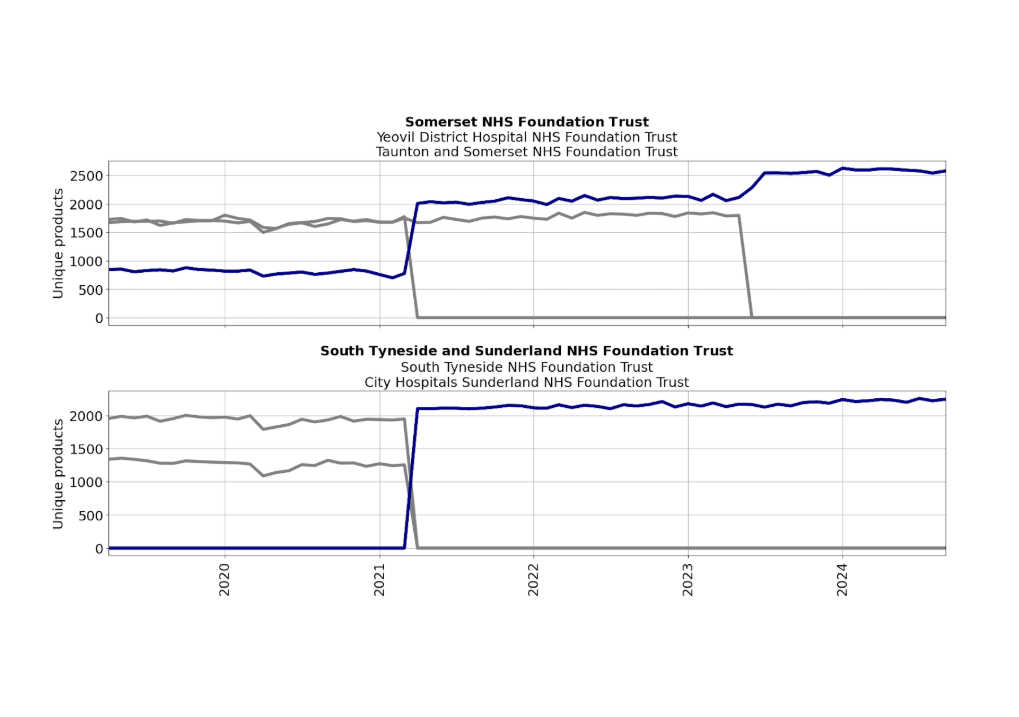Organising Organisations: Data consistency
- Posted:
- Written by:
-
- Louis Fisher,
- Steve Black,
- Vicky Speed,
- Brian MacKenna
- Categories:

This article is part of a series: OpenPrescribing Hospitals: Organising Organisations
Organising Organisations: Data consistency
Our previous blog looked at the completeness of organisational data in SCMD. It showed that some monthly data was missing for some trusts and we explained that some of this was to be expected due to organisational changes. When trusts do submit their data, the stock they issue is expected to be relatively consistent over time. In this blog, we will look at whether that is the case by looking at the number of products each trust issues each month.
Is the data submitted by each organisation each month consistent?
In our previous blog in which we had a first look at the data within the SCMD, we saw that the number of medicines and devices issued by NHS Trusts varied due to the different types of trusts included within the dataset. We did this by looking at the number of unique products each Trust submitted quantity data for across the entire period the dataset has been published. We can use the same metric to look at how consistent the number of products each trust issues each month is.
Below are a couple of examples: a small community trust (Wirral Community Health And Care NHS Foundation Trust) and one of the largest NHS Trusts in England (Barts Health NHS Trust).

Whilst Barts issues many more products (note the different y-axis scales), both show a stable pattern in the number of products they issue.
This isn’t the case for all NHS Trusts. For example, below it the number of unique products issued each month for University College London Hospitals NHS Foundation Trust. Whilst stable from December 2019, the months prior contain data for <10% of the products issued after this date. This likely represents missing data rather than a genuine change in activity.

What about when organisations change?
In the previous blog we showed that there are varying patterns of data submissions that occur across organisations that undergo mergers of acquisitions. There are also interesting patterns in the number of products these organisations submit data for during these periods.
In the figure below, the number of unique products issued each month for a selection of organisations that have been restructured is shown, with the ultimate successors shown in blue and their predecessors shown in grey.

The top chart shows Weston Area Health NHS Trust merging with the larger, existing University Hospitals Bristol and Weston NHS Foundation Trust. Following the merger, the number of products issued drops to 0, as it is no longer submitting data. There isn’t any obvious change in the number of products issued by the successor trust.
Somerset NHS Foundation Trust has had multiple organisational changes: a merger with Taunton and Somerset NHS Foundation Trust, followed by a merger with Yeovil District Hospital NHS Foundation Trust. Unlike the previous chart, following each of these changes, the number of unique products issued each month increased.
The bottom chart shows the formation of a brand new trust from the merger of two existing Trusts.
What does this mean when working with the data?
This highlights that, as well as being aware of missing data submissions by individual trusts, we also need when data is submitted, it can be inconsistent. These inconsistencies can be spotted by looking at changes across the number of unique products trusts issue each month, which can likely be done programmatically.
However, there are legitimate changes in the number of products issued by trusts that occur around organisational changes. To make spotting any unexpected changes across such trusts easier, data for predecessor trusts can be aggregated into that of their successor. We’ve had a go at this as part of the Submission History feature of OpenPrescribing Hospitals, which aims to surface the issues we’ve covered so far in this blog series and to make them easier to understand. We’ll explain it in more detail in the next blog.
There may be good reasons for the patterns we have shown above that we aren’t aware of, so if you think we’ve missed something, please let us know!


